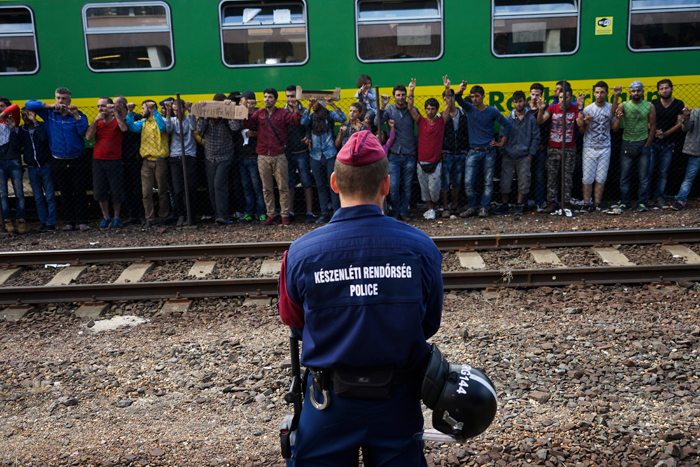European refugee crisis spotlights legal challenges
01 February 2016 | Story by Newsroom
The refugee crisis in Europe has not only highlighted the limitations of dated international laws on asylum seekers, but different interpretations of rules have clouded responses to the crisis, says refugee rights scholar Fatima Khan. She was speaking at this year's Summer School.
The refugee crisis in Europe has not only highlighted the limitations of dated international laws on asylum seekers, but different interpretations of the EU's Schengen rules and the Dublin Convention have clouded responses to the crisis, says refugee rights scholar Fatima Khan.
The situation has also made it harder for humanitarianism to win through, Khan noted in her 27 January Summer School lecture, 'The Refugee Crisis in Europe'.
Some 184 655 refugees have sought asylum in Europe in 2014, mainly from Syria, Eritrea, Afghanistan, Iraq and Iran. Reports indicate that there are 47 555 refugees in Germany; 33 025 in Sweden; 20 640 in France; 20 630 in Italy; 15 575 in Switzerland, and 14 065 in the United Kingdom.
Director of the Refugee Rights Unit in the law faculty, Khan's well-attended lecture presented a timely perspective on this migration and the limitations of legal frameworks drafted to address refugee crises in the previous century.
Khan said that this is not the first time Europe had seen a refugee crisis of these proportions; Europe had to deal with refugees after World War 2 when 12 million Germans were expelled from European countries and sent back to Allied-controlled Germany and Austria.
Then followed the 1956 Hungarian Revolt, which displaced 250 000 people, and the 1994 Balkan Crisis when three million fled the region.
Europe has also received smaller numbers of refugees from outside Europe in previous years, “but the difference is that this is the first time non-European refugees are entering Europe for the purposes of seeking asylum in such big numbers and in groups, literally walking into Europe”, she added.
Emotive images of the crisis playing out in the Mediterranean and at various European state borders have also polarised EU residents, eliciting sympathy or fear. This is evident in the way Germany and Hungary have dealt with asylum seekers; Germany first welcoming refugees but the Hungarian authorities being heavy handed and restrictive.
Outdated Convention
At the core of the legal process governing asylum seekers is the United Nations' 1951 Refugee Convention, designed to handle the post-WW2 refugee crisis in Europe. Sixty-five years later, it still dominates legal interpretations of who is deemed to be a legitimate refugee, where refugees are allowed to apply for asylum, and whether they should be allowed to transit through countries other than their 'first port of call'.
While the 1967 Protocol expanded the Convention's scope, scholars and critics have argued that the drafters of this legislation could not have foreseen the complex problems that would drive asylum seekers in the 21st century: economics, climate, terrorism and religious persecution.
Another legal complication comes in the guise of the EU's own Schengen rules.
While Schengen rules bind member countries in terms of trade and currency and travel, it doesn't do so in the way individual governments enforce border control and migration policies vis a vis asylum seekers.
And then there is the Dublin System, designed to eliminate “asylum shopping”, in other words when a refugee's asylum procedure is held in several EU countries at the same time or successively. It's also designed to prevent the phenomenon of “refugee in orbit”.
According to the Dublin System, the first country a refugee enters is responsible for accepting or rejecting asylum, so that there aren't applications in multiple countries.
But this hasn't stopped the current influx from targeting those countries they feel are more welcoming, and offer better economic prospects. As a result, the situation has severely tested the EU's asylum rules and strained relations between members.
What next?
It's good enough reason to ensure a humanitarian response comes first in responding to the crisis, says Khan.
“Every effort should be made to step up rescues and ensure safe passage for refugees and co-ordinate national policies with regard to humanitarian assistance.”
But it's clear that new rules are necessary, particularly to relieve those countries carrying the highest burden and to share it among all member states. Burden sharing is part of international law and not only in the EU, said Khan.
“It should be applied as a general principle.”
She also called for a consistent application of the EU rules to asylum seekers, for example, ensuring that there are no criminal penalties for illegal entry, no discrimination on the basis of race, religion, etc. and that certain behaviours are prohibited among border guards.
Story by Helen Swingler. Photo By Mstyslav Chernov via Wikimedia Commons.
 This work is licensed under a Creative Commons Attribution-NoDerivatives 4.0 International License.
This work is licensed under a Creative Commons Attribution-NoDerivatives 4.0 International License.
Please view the republishing articles page for more information.










